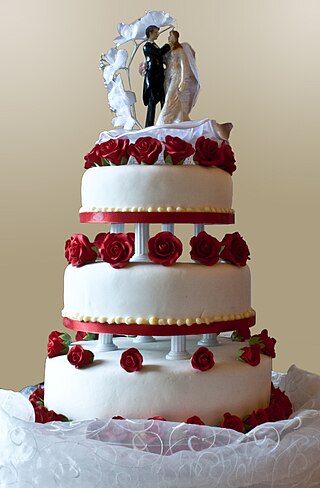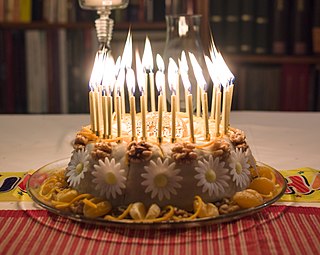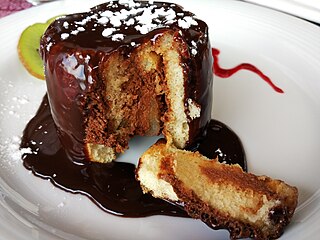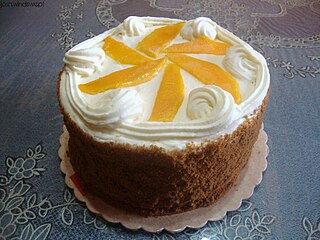
Dessert is a course that concludes a meal. The course consists of sweet foods, such as candy, and possibly a beverage such as dessert wine and liqueur. Some cultures sweeten foods that are more commonly savory to create desserts. In some parts of the world there is no tradition of a dessert course to conclude a meal.

Cake is a flour confection made from flour, sugar, and other ingredients and is usually baked. In their oldest forms, cakes were modifications of bread, but cakes now cover a wide range of preparations that can be simple or elaborate and which share features with desserts such as pastries, meringues, custards, and pies.

Pastry is baked food made with a dough of flour, water and shortening that may be savoury or sweetened. Sweetened pastries are often described as bakers' confectionery. The word "pastries" suggests many kinds of baked products made from ingredients such as flour, sugar, milk, butter, shortening, baking powder, and eggs. Small tarts and other sweet baked products are called pastries as a synecdoche. Common pastry dishes include pies, tarts, quiches, croissants, and pasties.

A wedding cake is the traditional cake served at wedding receptions following dinner. In some parts of England, the wedding cake is served at a wedding breakfast; the 'wedding breakfast' does not mean the meal will be held in the morning, but at a time following the ceremony on the same day. In modern Western culture, the cake is usually on display and served to guests at the reception. Traditionally, wedding cakes were made to bring good luck to all guests and the couple. Nowadays, however, they are more of a centerpiece to the wedding and are not always even served to the guests. Some cakes are built with only a single edible tier for the bride and groom to share, but this is rare since the cost difference between fake and real tiers is minimal.

A birthday cake is a cake eaten as part of a birthday celebration. While there is no standard for birthday cakes, they are typically highly decorated layer cakes covered in frosting, often featuring birthday wishes and the celebrant's name. In many cultures, it is also customary to serve the birthday cake with small lit candles on top, especially in the case of a child's birthday. Variations include cupcakes, cake pops, pastries, and tarts. In more recent years, it has become a common flavour for confectionery including ice cream, PopTarts, various cereal varieties among others. The flavour is usually vanilla with sweeter hints to imply sprinkles.

Cheesecake is a sweet dessert made with a soft fresh cheese, eggs, and sugar. It may have a crust or base made from crushed cookies, graham crackers, pastry, or sometimes sponge cake. Cheesecake may be baked or unbaked, and is usually refrigerated.

Icing, or frosting, is a sweet, often creamy glaze made of sugar with a liquid, such as water or milk, that is often enriched with ingredients like butter, egg whites, cream cheese, or flavorings. It is used to coat or decorate baked goods, such as cakes. When it is used between layers of cake it is known as a filling.

A cupcake (AmE), fairy cake (BrE), or bun (IrE) is a small cake designed to serve one person, which may be baked in a small thin paper or aluminum cup. As with larger cakes, frosting and other cake decorations such as fruit and candy may be applied.

A mille-feuille, also known by the names Napoleon in North America, vanilla slice in the United Kingdom, and custard slice, is a French dessert made of puff pastry layered with pastry cream. Its modern form was influenced by improvements made by Marie-Antoine Carême.

A layer cake or sandwich cake is a cake consisting of multiple stacked sheets of cake, held together by frosting or another type of filling, such as jam or other preserves. Most cake recipes can be adapted for layer cakes; butter cakes and sponge cakes are common choices. Frequently, the cake is covered with icing, but sometimes, the sides are left undecorated, so that the filling and the number of layers are visible.

A Swiss roll, jelly roll, roll cake, cream roll, roulade or Swiss log is a type of rolled sponge cake filled with whipped cream, jam, or icing. The origins of the term are unclear; in spite of the name "Swiss roll", the cake is believed to have originated elsewhere in Central Europe, possibly Austria or Slovenia. It appears to have been invented in the nineteenth century, along with Battenberg cake, doughnuts, and Victoria sponge. In the U.S., commercial snack-sized versions of the cake are sold with the brand names Ho Hos, Yodels, Swiss Cake Rolls, and others. A type of roll cake called Yule log is traditionally served at Christmas.

A génoise, also known as Genoese cake or Genovese cake, is a French sponge cake named after the city of Genoa and associated with French cuisine. It was created by François Massialot in the late 17th century. Instead of using chemical leavening, air is suspended in the batter during mixing to provide volume.

A charlotte is a type of bread pudding that can be served hot or cold. It is also referred to as an "icebox cake". Bread, sponge cake, crumbs or biscuits/cookies are used to line a mold, which is then filled with a fruit puree or custard. The baked pudding could then be sprinkled with powdered sugar and glazed with a salamander, a red-hot iron plate attached to a long handle, though modern recipes would likely use more practical tools to achieve a similar effect.

Sponge cake is a light cake made with egg whites, flour and sugar, sometimes leavened with baking powder. Some sponge cakes do not contain egg yolks, like angel food cake, but most of them do. Sponge cakes, leavened with beaten eggs, originated during the Renaissance, possibly in Spain. The sponge cake is thought to be one of the first non-yeasted cakes, and the earliest attested sponge cake recipe in English is found in a book by the English poet Gervase Markham, The English Huswife, Containing the Inward and Outward Virtues Which Ought to Be in a Complete Woman (1615). Still, the cake was much more like a cracker: thin and crispy. Sponge cakes became the cake recognised today when bakers started using beaten eggs as a rising agent in the mid-18th century. The Victorian creation of baking powder by English food manufacturer Alfred Bird in 1843 allowed the addition of butter to the traditional sponge recipe, resulting in the creation of the Victoria sponge. Cakes are available in many flavours and have many recipes as well. Sponge cakes have become snack cakes via the Twinkie.

Ube cake is a traditional Filipino chiffon cake or sponge cake made with ube halaya. It is distinctively vividly purple in color, like most dishes made with ube in the Philippines.

Mango cake or mango chiffon cake, is a Filipino layered chiffon cake infused with ripe sweet Carabao mangoes. It is typically topped with mango cream frosting, fresh mango slices, or pureed mangoes in gulaman or gelatin. Other common toppings include cream, cream cheese, and chocolate. It also commonly sandwiches slices of mangoes between the layers. It is one of the most popular cake variants in the Philippines, where mangoes are abundant year-round. Commercial versions are also available in large bakery chains like Red Ribbon Bakeshop and Goldilocks Bakeshop, as well as individual recipes from restaurants, often with unique names. It is very similar to crema de mangga, except that mango cake uses layers of chiffon cake not broas or graham crackers. The two recipes can sometimes be combined, however.

Orange creamsicle cake is a cake containing orange and vanilla flavors that is named after the Popsicle-brand "Creamsicle" ice cream treat on a stick: a vanilla ice cream center coated in orange-flavored popsicle ice. A traditional version might just be an orange- and vanilla-flavored bundt cake, but there are no-bake versions of the cake made with ice cream and pudding, and other versions made with cakes that are frosted or served with orange marmalade.


















